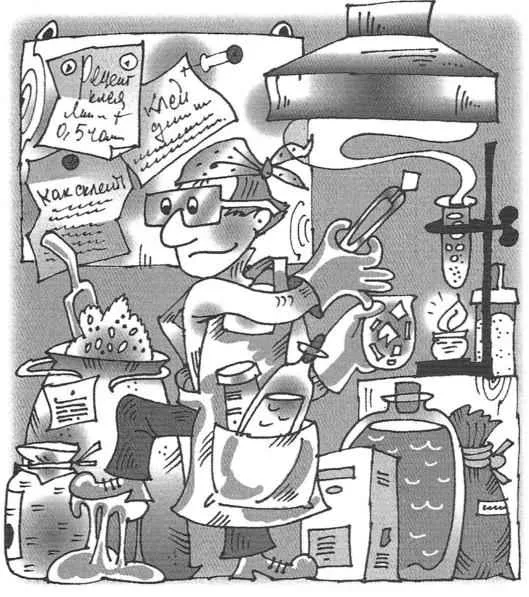 Advantages of adhesive bonding are well known. So to advertise no need. Amateur masters have long been actively using the method of bonding parts in their designs.
Advantages of adhesive bonding are well known. So to advertise no need. Amateur masters have long been actively using the method of bonding parts in their designs.
Currently, the range of materials has expanded considerably, and each requires its own glue. Need, unfortunately, is not always on sale. But in hardware stores and in the pharmacies you can buy individual components from which it is easy to make adhesives for many materials.
Today’s edition of the “Club house masters” introduces readers to recipes for adhesives that can be manufactured at home.
Celluloid glue suitable for gluing paper, cardboard, wood, fabric, and nitrocellulose. To craft it you need to take film or photographic film, to clean off the emulsion and finely chop. Then one weight part of scraps dissolved in two to three parts of acetone and held until complete dissolution for about a day. The glue should be stored in tightly closed containers.
Socionomy adhesive designed for bonding metal to rubber. For its preparation it is necessary two weight parts of lakomata dissolve in eight parts of dichloroethane.
Parts must be degreased and lubricated with glue initially, only the metal surface. Then, after half an hour, apply the glue and metal and rubber; after enduring another twenty minutes, apply the last glue. Parts tightly joined and dried ten minutes at a temperature of 200°C.
Ebony glue allows you to firmly glue the parts made from this material. For the preparation you must take six parts of pure rosin powder and one part of linseed oil. The composition, stirring, bring to a boil. Then the bonding surface is carefully trimmed with a file and heated at 60°C for twenty minutes. Then apply hot glue and join both surfaces. The cooled glue can be stored two or three years, but before use it must be heated once again.
Heat resistant glue allows you to glue parts that are exposed to temperature. It can also be used for insulation of heating elements. For cooking you need to mix six parts by weight of dry talc, silica glue (about ten parts). Silicate glue is added until, until the mixture becomes similar in consistency to sour cream. Glued parts or saisai-rovanie sections dried at room temperature for one hour. Next ten minutes, the part must be heated to a temperature of 100°C.
Wallpaper glue allows you to glue Wallpaper on virtually any wall. For cooking you need to stir in the cold water, sifted rye or wheat flour. Cost: one kilogram per ten litres of water. The solution should pass through a sieve, then heat, bring to a boil. After boiling a container of glue remove from the heat and diluted with cold water until thick sour cream. In order to dry the glue does not rot, you need to add a little alum. The gluing of wall-paper produced in the traditional way.
Glue for linoleum is an oil-Cretaceous mastic and glues any linoleum except koloksilinovogo. For cooking you need 47% of crushed and sifted chalk mix with 17% cement M400. Then the powder is added 36% of linseed oil “oksol” and mix thoroughly. Ready adhesive must be used within twenty hours.
Protein glue is suitable for bonding porcelain, earthenware, glass and ceramics. For cooking you need to whip some egg whites until frothy and defend ground in the day at room temperature. Then add gypsum or slaked lime. The powder was added to obtain a creamy mass. Adhesive must be used immediately after preparation. It is applied thinly on the pre-degreased surface. Then the blanks are held tightly together and dry day.
Glue for glass and metal. For its preparation you need to mix one weight part of copper oxide with one part abrasive powder and add three parts by weight of silicate glue. Thoroughly rubbed the mixture is applied to pre-fat the surface. Tightly clenching the parts, heat them to a temperature of 100°C and aged two hours. Then cooled to room temperature and leave for fifteen hours until the glue dries.
Syndetically glue allows you to glue the wood, affixing various materials. For cooking you need to take 200 g of dry wood glue, 200 g sugar, 70 g of slaked lime and 1 liter of water. First in the water dissolve the sugar and slaked lime. The solution was then heated on low heat until a clear liquid and filtered it. Then add the crushed carpenter’s glue, which is supposed to swell for about a day. Then spread it on the “water bath” like an ordinary joiner’s glue.
Glue for cardboard. For its preparation you need in 100 g of water successively dissolved 10 g of a silicate adhesive, 6 g of potato starch and add sugar to desired thickness. The entire mixture thoroughly mixed in a slightly heated condition. The glue is stored up to one year.
Glue for paper. Well glue any paper. For its preparation you need to iron the sheet is heated to dry potato starch. The obtained brown lumps to be ground into powder and dissolved in water at a ratio of 2/5. The shelf life of the adhesive is not limited.
Glue for tissue paper. For its preparation it is necessary to glue, made according to the previous recipe
add denatured alcohol until a syrupy liquid.
Book binding glue. Made on the basis of prepared wood glue followed by dissolving it in glycerol. The proportions – one part wood glue to twenty parts of glycerin.
Mastic “Bisky” well glue linoleum, parquet and tile. To prepare it you’ll need 6.5 kg of bitumen bn-70/30, 2.2 kg of white spirit, 0.4 kg of turpentine, 0.2 kg of rubber cement and 0.7 kg of cement M400. First of all heat the bitumen so it “melted”, and in small portions, with continuous stirring, adding cement. After removing the mixture from the heat and cool it to about 80°C, pour in all remaining ingredients. The bonding period is fully dry in about three days, and the surface it is advisable not to expose loads. The prepared adhesive is stored in tightly closed containers 2.5 – 3 months.
Polystyrene glue. For its preparation you need to crush 4 to 6 g of the polystyrene and dissolve it in 10 ml of benzene. The adhesive is applied with a soft brush on low fat surface. Then, having allowed it to dry a little (1 -3 min), parts should be impacting and drying at room temperature for 10 – 12 hours.
Adhesive for Plexiglas. It can be prepared according to the following recipes: a) 0.5-1 g of shavings of Plexiglas dissolved in 100 ml of dichloroethane; b) 5 g chips to dissolve in 100 ml of acetic acid; C) 5 g chips dissolve in 100 ml of 85% formic acid; d) 1 g of shavings, dissolve in a mixture of acetone and 60 ml of acetic acid and 40 ml.
The adhesive is applied on the degreased surface with a soft brush and immediately after that the parts need to connect and impact. Glued parts can withstand up to full curing of the glue for three hours.
Glue with alum is used for bonding of ceramics, glass and stone. For its preparation it is first necessary to dissolve the casein glue and 20 parts by weight. Him consistently to add 25 parts by weight of slaked lime and 3 parts of alum. Full drying time glued products – 24 hours.
Water-resistant adhesive. For its preparation it is necessary to mix 100 g of casein powder with cement M400 – 70 g. the resulting mixture fill with water – 200 ml. is obtained If the glue is thick, you should add polyvinyl acetate emulsion (PVA glue) or natural drying oil – 5% of the total weight of the adhesive. The adhesive should be used immediately after preparation. Glued products have a high mechanical strength and water resistance. It can be used as a sealant for glass aquariums.
Glue for ceramics. For its preparation it is necessary in a saturated solution of alum for a day to soak the plaster. After which it is dried and milled. The resulting powder is kneaded in water, as ordinary plaster. The adhesive is used immediately after preparation.
Glue for glass. For its preparation you need the gelatin to “dissolve” in 5% solution of potassium dvuhromovo. The ratio of both components was 1:1. The glue is prepared in a dark room and glued products is kept in sunlight for six hours. The glue does not dissolve in hot water.
In this collection given a number of recipes of adhesives, allowing you to connect a variety of materials. It only remains to add that prior to bonding, to obtain a durable connection, you need to clean the surface from dust and dirt, remnants of the old glue and paint. Wood and metal cleaned with a file and sandpaper. Of course, the surfaces must be degreased by any known methods.
S. FEDORENKO, g. Tsyurupinsk, Kherson region.



